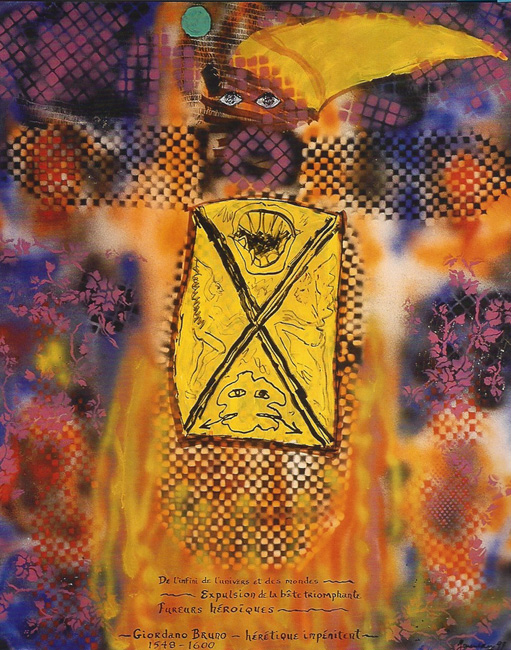Source: WTL© photograph of Gauvreau painting (1999) in Pierre Gauvreau; Passeur de modernité. Québec: Musée de la civilization, 2014, p. 144.
Images: "Les Insoumis No. III: Hommage No. 2 à Giordano Bruno" [The Unsubdued No. III: Hommage No. 2 to Giordano Bruno] (1999).
Comments: Gauvreau painted a first version of this theme when he was beginning his rebellious phase--truly, life-long project--in 1948. He returned to Giordano Bruno 51 years later in the painting above. Giordano Bruno (born as Filippo Bruno; 1548 - 1600) was a polymath friar in the Roman Catholic Dominican order, although, essentially, he was, or, at least, became a pantheist. He was highly accomplished in astronomy (and astrology), mathematics, and philosophy, and he was also a poet. Most famously, in 1593, he was tried by the Inquisition in Italy as a heritic, found guilty, and burned at the stake. The ideas that got him into trouble with the Church authorities included his elaboration on the Copernican theory that the stars were like our solar system's sun each with planets rotating around a central star and that such planets could have life on them similar to human life (Catholic dogma, on the contrary, held that humans were totally unique in the universe). Furthermore, anticipating contemporary astronomy, he posited that the universe was infinite with no specific center. You can see why Gauvreau, therefore, chose to create one of his "Insoumis" canvasses to the Giordano Bruno as a martyr for science and independence of thought.
The tiny French words at the bottom of the painting say: "De l'infini de l'uivers et des mondes / Expulsion de la bête triomphante / Fureurs héroiques / Giordano Bruno / hérétique impénitent (1548-1600)" [On the infinity of the universe and worlds / Expulsion of the triumphant beast / Heroic rage (1548-1600].
Humanities Questions: Keeping in mind the textual inscription at the bottom, analyze this painting by including in your commentary the cross structure in the middle, the central yellow rectangle, the head at the top with a penitent's hat, and the color scheme. Anything else you notice will be most appreciated.

